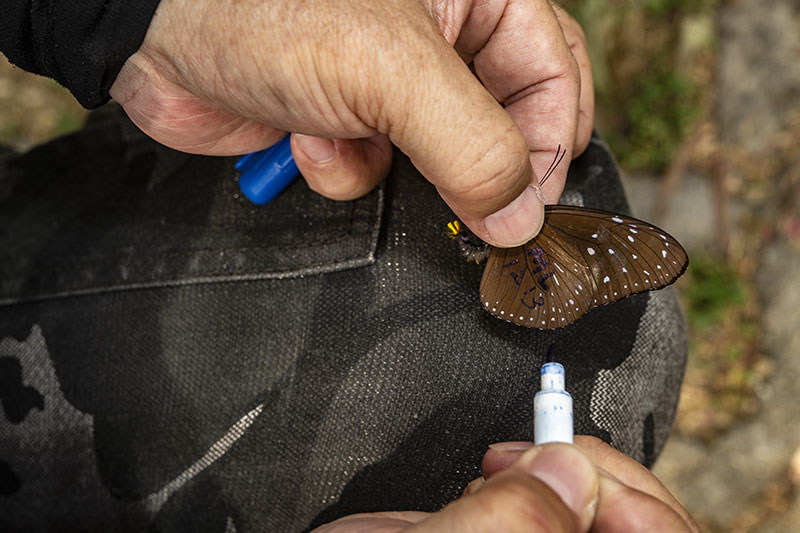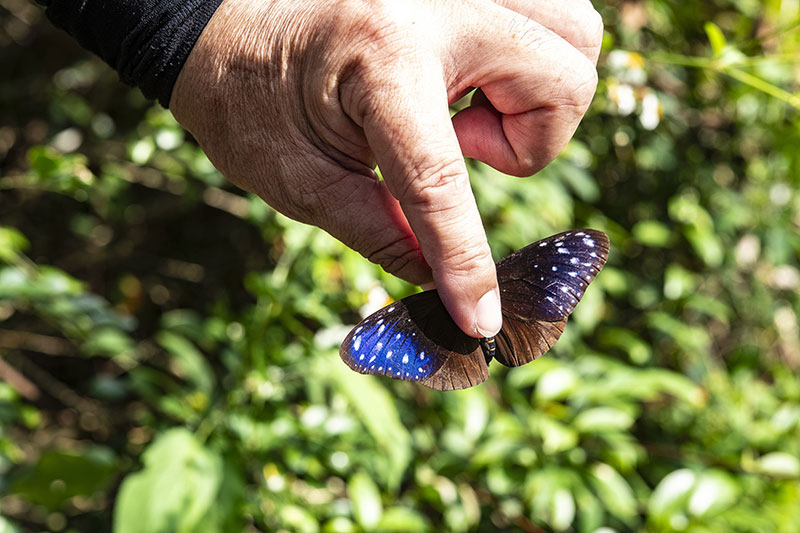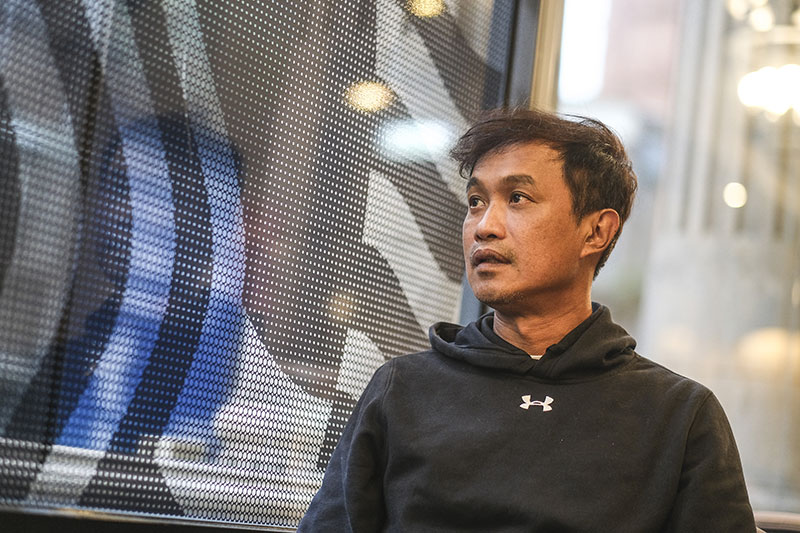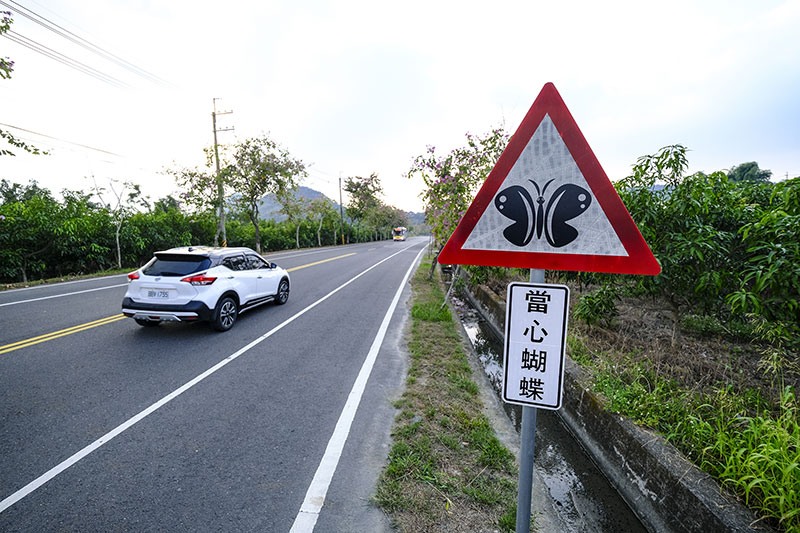
For over a decade researchers have been marking Taiwan’s crow butterflies, hoping to unravel the mystery of their migrations.
Every year, as the cold of winter begins to set in, crow butterflies quietly embark on their migration to the south. Hundreds of thousands of them gravitate towards Taiwan’s tropical valleys to winter there, bestowing a mystical allure upon these places. As warm weather returns, they begin to move north again. With upwards of 10,000 per minute flying across certain sections of the island’s highways, the spectacle is simply breathtaking.
While we all know that some birds move to warmer regions to spend the winter months, many of us would be surprised to learn that butterflies also undertake winter migrations. Sporting their characteristic purple sheen, crow butterflies winter in the valleys of Southern Taiwan. These migrants belong to four subspecies—all of them endemic to Taiwan.
A world-class spectacle
Documentary filmmaker Chan Chia-lung has spent decades chasing after butterflies. He tells us that crow butterflies, being tropical in origin, are unable to adapt themselves to cold climates, so the northern and southern limits of the tropics mark the boundaries of their distribution. Taiwan is divided by the Tropic of Cancer into tropical and subtropical zones. In summer, crow butterflies can be found breeding all over the island, but in winter, because the weather in the north is inhospitable to them, they migrate to particular valleys in the tropical south.
When winter approaches, these tiny creatures confound our imagination by traveling 200–300 kilometers to Southern Taiwan. Sometimes, appearing like clusters of grapes, they perch on twigs and branches to rest and shelter from the cold. Tree after tree is completely covered with them. At other times they rest on the banks of mountain streams to drink water, spreading into the distance like vast carpets. These wonders of nature led Dick Vane-Wright, author of Butterflies (published by the UK’s Natural History Museum in 2003), to mention Taiwan’s “valley[s] of purple butterflies” alongside the monarch butterflies of North America that stream to Mexico every autumn as one of the world’s two major seasonal migrations of butterflies. The spectacular sights have also attracted the attention of international media agencies, including CNN, the BBC, and National Geographic.
To gain a more intimate view of the beauty of crow butterflies, we visit the Maolin National Scenic Area in Kaohsiung and Pingtung—home to the greatest number of “purple butterfly valleys” in Taiwan, with an abundance of crow butterflies wintering here year after year. We join Liao Jinshan, director of the Taiwan Purple Crow Ecological Preservation Association and a volunteer guide at the scenic area. The walk from the visitor center to the square in the Eco Park of Maolin takes less than ten minutes, but along the way we’re already greeted by various species of butterflies, including crows and tigers in the subfamily Danainae, which flutter gracefully in the air.
Unlike the forest patches in Mexico which shelter vast numbers of a single butterfly species, Taiwan’s butterfly valleys provide winter refuge for four species of crows, as well as blue tigers and common tigers. Altogether, these crows and tigers are members of 12 different species of milkweed butterflies. The rich diversity makes Maolin’s butterfly valleys wonderfully colorful.

The iridescent colors of crow butterflies’ wings change with the intensity and angle of light and the position of the viewer. The ever-shifting colors are magical.
Wintering with the butterflies
Come October, crow butterflies will once again fly to Maolin, as if fulfilling a sacred pledge to this place. Every autumn and winter, from October to February, the scenic area hosts a series of events celebrating the crow butterflies. To welcome these indefatigable wayfarers, Liao’s colleagues not only carry out the usual conservation work on the habitats but also make secret preparations well in advance: in late summer and early autumn they plant flowers such as Kusukusu eupatorium whose nectar particularly attracts crow butterflies. Maolin’s butterfly season, which lasts four to five months, is an inexhaustible source of delights. Different weather conditions, flower species, and flowering phases afford different views of the airborne creatures. No wonder Michelin’s Green Guide to Taiwan gives three stars (the highest rating) to Maolin’s purple butterfly valleys. Many Japanese, Korean, European, and American tourists come here just to admire the butterflies.
Magical colors
Walking on Maolin’s Zishalishali Trail, we’re eagerly looking forward to meeting all four of Taiwan’s crow butterfly species: the blue-banded king crow (Euploea eunice hobsoni), the double-branded crow (E. sylvester swinhoei), the striped blue crow (E. mulciber barsine), and the dwarf crow (E. tulliolus koxinga). How can we tell them apart? There’s a memorable mantra in Chinese to assist us. It translates as this: “The dwarf has one spot; the blue-banded king, two; the double-branded, three; the striped blue, scattered ones.” These refer to the number of prominent white spots near the center of the undersides of their forewings, which enable us to easily distinguish one species from another.
If we’re fortunate enough to encounter crow butterflies in the wild, we may wonder about their ever-changing colors. Why is it that they look brown when resting in a dark wood? Why do they occasionally give off a sheen of purple while flying in the air, but look so dark in the photos we take on our phones? Chan Chia-lung explains that the “purple” is actually not the inherent color of these butterflies. Because the minute scales on their wings have complex nanostructures that cause the interference of light waves, we see different colors reflected off them, depending on where we stand and on the intensity and angle of light. This phenomenon is known as iridescence. “We say that the colors undergo 17 changes a second, but actually there are more. Of course there are! From various shades of blue to shades of purple, pink, and sometimes even a hint of yellow, these chromatic shifts happen instantaneously,” Chan says with excitement.

Chan Chia-lung believes that the winter migration of Taiwan’s crow butterflies is a special and precious phenomenon that calls for careful protection.
A rich life
Chan’s documentary Lost Butterfly was released in 2023 with a view to bringing Taiwan to the attention of the wider world and encouraging more local people to explore the mystery of these creatures that live around them.
Chan used a high-speed camera to capture the moments when crow butterflies took to the air, and their changing colors, in 4K resolution at a frame rate of 1,000 per second. Singer Deserts Chang narrated the script with her mesmerizing voice, sometimes introducing the secrets of crow butterflies to the audience in accessible language, sometimes seeming to engage in a friendly conversation with the butterflies themselves, making their feelings known to us. The life of crow butterflies vividly unfolds on the screen: from the caterpillars (larvae) hatching out from the eggs and dodging all sorts of dangers as they grow, to the chrysalises (pupae), which look like shiny pieces of gold, and finally the climactic emergence of the beautiful butterflies.
But the story doesn’t end there. The average lifespan of an adult crow butterfly is from six to nine months, much longer than that of other butterflies. When winter comes, they set out on their long journey to the warm south. We learn from the documentary that far from spending their lives gathering nectar at leisure, they have to battle to survive. For Chan, the crow butterfly is “another kind of creature with a soul. Its intelligence may be different from yours, but the trajectory of its life is interspersed with moments of happiness and anguish, much like that of a human being. It, too, lives a rich life.”
Priority for butterflies
Chan reveals that he used to dream of chasing after rare butterflies. Common in many places across Taiwan, crow butterflies didn’t spark his enthusiasm. It was during a visit to a butterfly valley, where tens of thousands of crow butterflies gathered, that he was bowled over by the sheer grandeur of the scene. He wondered how these tiny insects could ever have come together to achieve such mind-boggling sublimity, and the idea of probing the secrets of their migrations began to form in his mind.
Having marked one crow butterfly after another and tracked their movements, Chan and the volunteers gradually obtained a fuller picture of the migration routes. The section of National Highway 3 that runs through Linnei in Yunlin County crosses the northward migration route that crow butterflies follow in spring. The fast-moving traffic here is deadly for the fragile migrants. Thanks to a campaign launched by Chan and his colleagues, the highway authorities set up measures to help the butterflies get across safely. In addition to protective netting on either side of the freeway, which encourages the butterflies to fly higher, a stretch of the outer lane is closed whenever the number of butterflies crossing here exceeds 250 per minute. Measures like these are rare anywhere in the world. In 2007 Chan won the overseas category of the Japan Fashion Association’s Creation Awards for his lifelong dedication to protecting Taiwan’s crow butterflies.

Roads around Maolin have signs asking drivers to look out for crow butterflies. Protective measures are also being implemented on freeways. These reflect the Taiwanese people’s commitment to the butterflies’ survival.
Safeguarding the butterflies
Chan’s documentary work in Maolin has come to a close, but people like Liao Jinshan and Tang Xiongjing have taken on his mantle. The Tse-Xin Organic Agriculture Foundation (TOAF) is another notable contributor. Extending its work to Maolin in 2010, the non-profit organization is committed to helping mango growers here cut down on the use of chemicals. The produce is bought and made into dried mangoes by Leezen, a major organic retail chain in Taiwan. Even though eco-friendly farming practices lead to less predictable harvests, the elimination of pesticides is a vital step forward for the conservation of butterfly habitats. Many local farmers have supported the initiative for over a decade, and have never looked back.
But Maolin is not the only place favored by crow butterflies. Kenting National Park on the Hengchun Peninsula provides a vast breeding ground for them. In recent years researchers have discovered that the section of Nanwan Road outside the Ma’anshan Nuclear Power Plant near Kenting is another hotspot for crow butterflies during their breeding season. Every May and June, we see large numbers of them flying across the road. The national park administration plans to install protective netting along the Nanwan section of Provincial Highway 26 this year, and is seeking to lower the speed limit here in order to ensure the safety of the butterflies.
Chan Chia-lung remarks that the winter migration of crow butterflies in Taiwan may be regarded as a unique local phenomenon. Crow butterflies are not endangered species, but with the planet becoming ever warmer, the day may come when they won’t need to migrate anymore. Coupled with the destruction of natural habitats, climate change signals the possibility that Taiwan’s precious “purple butterfly valleys” may one day disappear.
It was not until 300 years after the extinction of the dodo that a hypothesis was put forward which connected the disappearance of these Mauritian birds with the supposedly impending extinction of the tambalacoque (Sideroxylon grandiflorum): it was thought that the seeds of the tree could germinate only by passing through the digestive tracts of dodos. Likewise, butterflies are inextricably connected with other beings. We cannot fully predict the concatenation of ecological events that may be brought about by the extinction of a particular butterfly species. But one thing is for sure: to safeguard crow butterflies is to protect not just the trees they perch on, but entire forests as well. Tiny but startlingly beautiful, Taiwan’s crow butterflies are themselves inspirational paeans to life.
For more pictures, please click 《Paeans to Life: The Secrets of Crow Butterflies》











